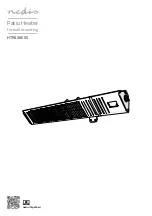
22
3
.
MAKING THE JOINT
A. Cutting
Pipe must be squarely cut to allow for the proper interfacing of the
pipe end and the fi tting socket bottom. This can be accomplished
with a miter box saw or wheel type cutter. Wheel type cutters are
not generally recommended for larger diameters since they tend
to fl are the corner of the pipe end. If this type of cutter is used,
the fl are on the end must be completely removed.
NOTE: Power saws should be specifi cally designed to cut plastic
pipe.
STEP A
B. Deburring
Use a knife, plastic pipe deburring tool, or fi le to remove burrs
from the end of small diameter pipe. Be sure to remove all burrs
from around the inside as well as the outside of the pipe. A slight
chamfer (bevel) of about 10°-15° should be added to the end
to permit easier insertion of the pipe into the end of the fi tting.
Failure to chamfer the edge of the pipe may remove cement from
the fi tting socket, causing the joint to leak.
STEP B
C. Test dry fi t of the joint
Tapered
fi tting sockets are designed so that an interfaced fi t
should occur when the pipe is inserted about 1/3 to 2/3 of the
way into the socket. Occasionally, when pipe fi tting dimensions
are at the tolerance extremes, it will be possible to fully insert
dry pipe to the bottom of the fi tting socket. When this happens,
a suffi cient quantity of cement must be applied to the joint to fi ll
the gap between the pipe and fi tting. The gap must be fi lled to
obtain a strong, leak-free joint.
D. Inspection, cleaning, priming
Visually inspect the inside of the pipe and fi tting sockets and
remove all dirt, grease or moisture with a clean dry rag. If wiping
fails to clean the surfaces, a chemical cleaner must be used.
Check for possible damage such as splits or cracks and replace
if necessary.
Depth-of-entry
Marking the depth of entry is a way to check if the pipe has
reached the bottom of the fi tting socket in Step F. Measure
the fi tting depth and mark this distance on the pipe O.D. You
may want to add several inches to the distance and make a
second mark as the primer and cement will most likely destroy
your fi rst one.
Apply primer to the surface of the pipe and fi tting socket with a
natural bristle brush. This process softens and prepares the PVC,
ABS or CPVC for the solvent cementing step. Move quickly and
without hesitation to the cementing procedure while the surfaces
are still wet with primer.
E. Application of solvent cement
• Apply the solvent cement evenly and quickly around the outside of the
pipe at a width a little greater than the depth of the fi tting socket.
• Apply a light coat of cement evenly around the inside of the
fi tting socket. Avoid puddling.
• Apply a second coat of cement to the pipe end.
STEP E
F. Joint assembly
Working quickly, insert the pipe into the fi tting socket bottom and
give the pipe or fi tting a 1/4 turn to evenly distribute the cement.
Do not continue to rotate the pipe after it has hit the bottom of the
fi tting socket. A good joint will have suffi cient cement to make a
bead all the way around the outside of the fi tting hub. The fi tting
will have a tendency to slide back while the cement is still wet
so hold the joint together for about 15 seconds.
STEP F
G. Cleanup and joint movement
Remove all excess cement from around the pipe and fi tting with a
dry cotton rag. This must be done while the cement is still soft.
The joint should not be disturbed immediately after the cementing
procedure, and suffi cient time should be allowed for proper curing
of the joint. Exact drying time is diffi cult to predict because it
depends on variables such as temperature, humidity and cement
integrity. For more specifi c information, you should contact your
solvent cement manufacturer.
STEP G
Содержание POWER DIRECT VENTED GAS MODELS
Страница 3: ...3 ...
Страница 23: ...23 ...
Страница 34: ...34 NOTES ...
Страница 35: ...35 NOTES ...















































